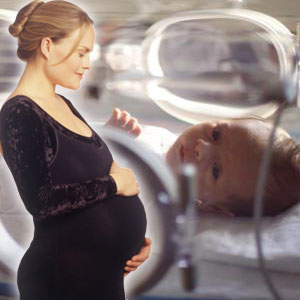High Risk Pregnancy

It is estimated that about 5- 10% of pregnancies can be called 'high risk'. Studies reveal that in the forthcoming years, one out of every four pregnant women is likely to experience complications. A pregnancy is termed 'high risk' when it is complicated and the life and health of the mother and the fetus may be at risk. The babies born out of high risk pregnancies are preterm and prone to serious health problems.
Mothers with chronic medical conditions like diabetes, cardiac disorders, chronic hypertension, and asthma or with suspected RH negative and genetic problems suffer high risk pregnancies. But all is not lost for high risk mothers. Families and mothers can successfully cope with medical intervention, education and a strong support system to overcome and deliver healthy babies.
Causes for high risk pregnancy
A woman's medical status, lifestyle or external factors may be the cause for high risk pregnancy. Some complications are unavoidable, while the risk in some others can be minimized by the help of the gynecologist / physician. Many times complications can also occur without any warning signal. Sometimes causes and risk factors can be identified early and suitably treated.
Anemia in pregnancy: Anemia occurs when the red blood cells are too few in the body. This leads to a lowered ability of the red blood cells to carry oxygen. Since the fetus is dependant on the mother's blood anemia can cause poor fetal growth, preterm birth and low birth weight. Anemia of pregnancy, iron deficiency anemia, vitamin B 12 deficiency, anemia due to blood loss, folate deficiency anemia are some of the types of anemia during pregnancy.
Anemia is diagnosed during the prenatal examinations through routine blood test for hemoglobin and hematocrit levels. Specific treatment for anemia is rendered depending on the severity of the condition. This includes intake of iron supplements, citrus juices and good sources iron like meats, poultry, fish, leafy greens, legumes, yeast and cereals.
Preterm labor: In high risk pregnancies more than 11% of the babies born are preterm. Preterm labor begins before completion of thirty seven weeks of pregnancy. Preterm labor may mean either uterine contractions, rupture of amniotic sac and/or cervical dilatation. Many factors can contribute to preterm labor. Some of the key factors are:
- Maternal factors like pre eclampsia, chronic medical illness, infection like urinary tract infections, vaginal infections, drug abuse, abnormal structure of the uterus, cervical incompetence, previous preterm birth.
- Factors involving pregnancy like abnormal or decreased function of the placenta, placenta previa and abruption, premature rupture of membranes
- Factors involving the fetus like behavior of intrauterine environment, multiple gestation and erythrobalstois fetalis which means Rh blood group incompatibility.
Premature babies born out of preterm labor may experience temperature instability, respiratory problems, cardiovascular deficiency, blood and metabolic disorders, gastrointestinal difficulties, neurologic hemorrhages and other infections. Such premature babies may suffer from long term health problems as well.
Treatment for preterm labor includes bed rest for the mother at home or hospital, medications inclusive of corticosteroids, cervical cerclage whereby the cervix opening is sutured and cesarean delivery of the baby in certain cases if the fetus or mother is in danger.
Intrauterine Growth Restriction (IUGR): This is a condition in which the fetus is smaller than expected for the number of weeks of pregnancy or there is fetal growth restriction. Newborn babies with IUGR are small for their gestational age. The baby's fetal weight is less than the 10th percentile. The fetus with IUGR may be born at term or prematurely. They appear thin, pale and have loose dry skin. Some have a wide eye look.
IUGR can begin at any time of pregnancy. While early onset of IUGR is due to chromosomal abnormality, late onset is due to other related problems. Although it is not possible to prevent IUGR, it can normally well managed by the doctor.
Generally the earlier and more severe the growth restriction, the greater the risk. Careful monitoring of the fetus growth is needed in all cases of IUGR. This is done by ultrasound and Doppler studies and mother's weight gain monitoring. Other ways to watch the potential high risk is by fetal movement counting, non stress testing, and biophysical profile examination.
Post term pregnancy: In contrast to preterm pregnancy, post term pregnancy lasts for more than forty two weeks. About 7% of babies are born at forty two weeks or later. Such post term pregnancies can cause longer hours of labor and operative delivery. Mothers are at increased risk for vaginal birth trauma due to large baby. Cesarean deliver is likely for post term babies.
Multiple pregnancy: Multiple pregnancy means two or more fetuses. A very small percentage (about 3%) of women experiences multiple pregnancy.
Post partum hemorrhage: This is when excessive bleeding follows the birth of the baby in the mother. About 4% of women have post partum hemorrhage. Immediate medical intervention is required to stop bleeding. Some women with placental abruption and placenta previa are more susceptible for post partum hemorrhage than others.
RH disease: This disease occurs when there is incompatibility between the blood of the mother and the baby. This again is a high risk factor in pregnancy.
Premature rupture of membranes: Premature rupture of membranes means breaking open of the membranes before labor begins, especially before thirty seven weeks of pregnancy. Nearly 10% of pregnancies suffer premature rupture of membranes.
Rupture or membranes is caused by natural weakening of membranes or from force of contractions. Low socioeconomic conditions, sexually transmitted infections, previous preterm birth, vaginal bleeding and cigarette smoking during pregnancy are some of the main causes for premature rupture of membranes. One third of the premature births suffer from premature rupture of membranes.
Gestational diabetes: Diabetes in pregnancy can have serious consequences for the mother and the fetus. The severity of the problem depends upon the degree of the mother's diabetic disease. In the US about 9 % if women have diabetes and one third of them do not know it. 2 to 3% of women develop diabetes during pregnancy called gestational diabetes. Here the mother who does not have diabetes develops a resistance to insulin because of the hormones of pregnancy.
Treatment for gestational diabetes focuses on keeping the blood glucose levels under control. Special diet, exercise, blood glucose monitoring daily and insulin injections are some of the modalities of treatment for gestational diabetes.
Pregnancy induced hypertension: It occurs in about 5 to 8% of pregnancies. Another type of blood pressure is called chronic hypertension which is present before pregnancy begins. Pregnancy induced hypertension is called pre eclampsia or toxemia.
Untreated high blood pressure during pregnancy could hinder blood flow in the organ systems of the expectant mother. Complications such as placental abruption may result because of high blood pressure. Pregnancy induced hypertension can also potentially cause dangerous seizures and even death in the mother and fetus if left untreated.
HELLP syndrome: This is a serious complication of severe pregnancy induced hypertension and in occurs in about 2 to 12 % of women. It develops before delivery. HELLP syndrome can result in breakdown of red blood cells causing anemia and blood clotting problems leading to disseminated intravascular coagulation.
Bleeding in pregnancy: Bleeding may occur at any time during pregnancy. Bleeding may or may not produce complications. Time of bleeding, amount and pain while bleeding are dependent upon the cause of bleeding. Bleeding may occur due to miscarriage, ectopic pregnancy and gestational trophoblastic disease which are a rare condition that may be cancerous.
Maternal and fetal infections: Infectious disease may vary from common illnesses such as cold to deadly diseases like Acquired Immune Deficiency Syndrome (AIDS). Infections spread through sexual, airborne, blood borne and direct skin contact transmissions.
Other potential risk factors
Underweight or over weight mothers, mother with previous preterm birth, poor nutritional status, previous pregnancy loss, family history of genetic diseases, infertility medications are some of the other factors which need to be considered from preconception stage. Pre-existing medical conditions coupled with life style factors contribute to high risk pregnancies in most mothers to be.
However external risk factors like consuming alcohol, smoking, drug abuse, exposure to high temperatures and altitudes, exposure to radiation can also pose a potential and serious threat to the growing fetus.
Top of the Page: High Risk Pregnancy
Tags:#high risk pregnancy
 Planning Pregnancy
Planning Pregnancy Pregnancy Diet and Exercise
Healthy Weight Gain in Pregnancy
Pregnancy Food Cravings
Pregnancy Heartburn
Improving Fertility after 35
Ovulation Test Strips
Pregnancy Symptoms
Early pregnancy cramping
Early pregnancy Test
High Risk Pregnancy
More on Pregnancy
 Natural Childbirth
Natural Childbirth Premature Birth
Pregnancy Massage
Pregnancy Problem
Pregnancy Due Date Calculator
Amniocentesis
Twin Pregnancy
Ectopic Pregnancy
Pregnancy Morning Sickness
Molar Pregnancy
Pregnancy Ultrasound
Constipation during pregnancy
Insomnia during Pregnancy
Smoking during Pregnancy
Teen Pregnancy
Exercise during pregnancy
Late Term Abortion
Sign of Miscarriage
Pregnancy Fatigue
Pregnancy Gas
Pregnancy sciatica
Belly Wrap after Pregnancy
Emotional Health during Pregnancy
Lactating Mother
Infertility
Recurrent Miscarriage
Pregnancy Varicose Veins
Postpartum Depression
Epidural
Premature Infant
Top of the Page: High Risk Pregnancy
Popularity Index: 100,604

